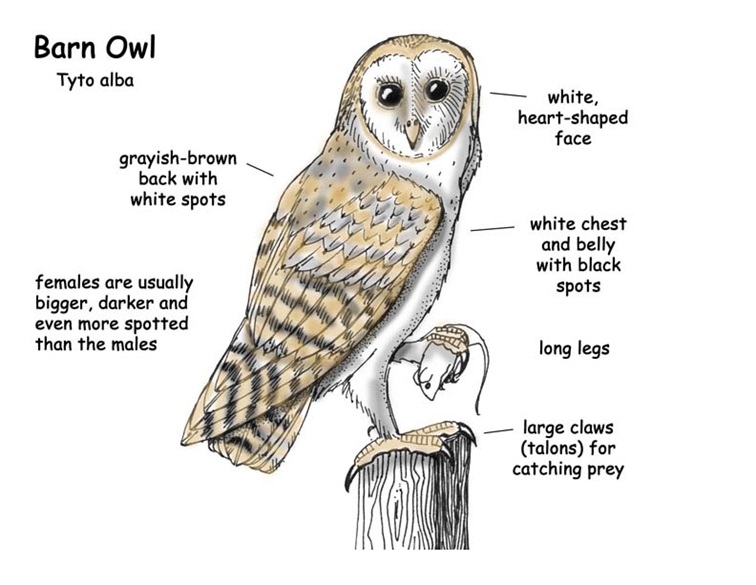Owls are among the most fascinating birds of prey, renowned for their distinctive appearance, hunting prowess, and mysterious nocturnal lifestyle. These magnificent creatures are perfectly adapted to thrive in diverse environments, thanks to their specialized body parts. Let’s explore the anatomy of an owl and uncover the roles of each body part in its survival and behavior.
A Body Parts Of Owl

1. Head and Facial Disc
The head of an owl is large and rounded, with a unique structure known as the facial disc. This disc, composed of specialized feathers, helps to direct sound waves to the owl’s ears, enhancing its hearing. Owls can also rotate their heads up to 270 degrees, thanks to their flexible necks and 14 cervical vertebrae (humans have only seven). This extraordinary ability allows them to scan their surroundings without moving their bodies, which helps in stealthy hunting.
Function:
- Amplifies sound for better hearing.
- Enables extensive head rotation for a wider field of vision.
2. Eyes
An owl’s eyes are large and tubular, unlike the spherical eyes of most birds. These forward-facing eyes give them excellent binocular vision, which is crucial for judging distances during hunting. Owls are also known for their exceptional night vision due to a high concentration of rod cells in their retinas.
Function:
- Provides sharp binocular vision for depth perception.
- Allows excellent vision in low light conditions, aiding nocturnal hunting.
3. Ears
Owls have asymmetrical ears, meaning one ear is positioned higher than the other. This unique trait helps them pinpoint the exact location of sounds, even in complete darkness. Some owl species, like the barn owl, have ear openings surrounded by specialized feathers to further enhance sound directionality.
Function:
- Detects minute sound differences for precise prey localization.
- Works in conjunction with the facial disc to amplify sound waves.
4. Beak
An owl’s beak is short, hooked, and downward-curving. This design is perfect for tearing flesh and consuming prey. Unlike many other birds, the base of an owl’s beak is covered by bristle-like feathers, which help protect its eyes while eating.
Function:
- Tears apart prey with precision.
- Protects eyes during feeding.
5. Talons
Owls possess powerful talons equipped with sharp claws. These talons are essential for grasping, killing, and carrying prey. The outer toe of an owl can rotate backward, allowing for a two-forward, two-backward grip (zygodactyl arrangement), which enhances its grasping ability.
Function:
- Captures and secures prey.
- Provides a strong grip for perching.
6. Feathers
Owls have soft, fringed feathers that enable them to fly silently. These feathers reduce noise by minimizing turbulence, giving owls a stealthy advantage during hunting. Additionally, the coloration and patterns of their feathers provide excellent camouflage, helping them blend into their surroundings.
Function:
- Facilitates silent flight for stealth.
- Provides insulation and camouflage.
7. Wings
An owl’s wings are broad and rounded, allowing for slow, controlled flight. This feature is especially useful when navigating dense forests or silently approaching prey. The wings also support soaring and gliding during hunting.
Function:
- Enables silent, controlled flight.
- Aids in maneuverability and gliding.
8. Legs
Owls have strong, feathered legs, which not only help in keeping them warm but also provide additional strength for capturing and holding prey. Their long legs allow them to reach into burrows or under vegetation to catch hidden prey.
Function:
- Provides strength for grasping prey.
- Enhances stealthy movement on the ground.
9. Tail
The tail of an owl is relatively short and broad, aiding in balance and maneuverability. The tail feathers are also designed to assist in silent flight, complementing the wings.
Function:
- Supports balance during flight and perching.
- Enhances agility and silent flight.
10. Body
The owl’s body is compact and lightweight, with a low center of gravity, which contributes to its exceptional agility. The body’s shape is also aerodynamically efficient, allowing the owl to conserve energy while flying.
Function:
- Facilitates energy-efficient flight.
- Provides agility for hunting and escape.
11. Digestive System
Owls have a unique digestive system that allows them to consume their prey whole. Indigestible parts, such as bones and fur, are compacted into pellets and regurgitated. This adaptation ensures the owl derives maximum nutrients from its food.
Function:
- Extracts nutrients efficiently.
- Prevents blockages by expelling indigestible material.
12. Vocal Organs
Owls use their syrinx, the avian vocal organ, to produce a variety of calls, hoots, and screeches. These sounds serve multiple purposes, including communication, territory defense, and mating.
Function:
- Facilitates communication and signaling.
- Establishes territory and attracts mates.
Conclusion
Each part of an owl’s body plays a critical role in its survival, whether it’s the silent flight enabled by specialized feathers or the sharp talons used to capture prey. These adaptations make owls some of the most efficient predators in the animal kingdom. By understanding their anatomy and functions, we gain a deeper appreciation for these incredible birds and their role in maintaining ecological balance.


